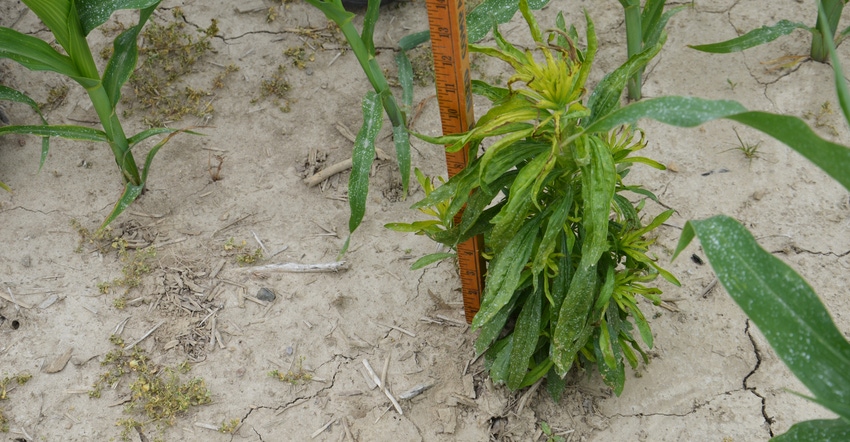
If you only have a few marestail weeds in the field and you want to give other broadleaves a chance to emerge before spraying postemergence herbicides, then having marestails that are a foot tall here and there is understandable. But if you have weeds that tall because you underestimated their size or the power of the chemical to take down big weeds, you may need to reconsider your weed control strategy.
The tale of the tape — or in this case, the tale of the yardstick — tells the story. The marestail pictured above was pushing past a foot tall when it was sprayed with postemergence herbicide. That’s big for any weed, and could even tall enough that it’s off-label for control of specific herbicides.
Stay or go?
Will the marestail in the picture burn down eventually and go away? Or will it survive even though it’s been set back for the season?
Dave Nanda, a crops consultant based in Indianapolis, believes this weed will be set back, but it may survive. Fortunately, there were only a few scattered marestail plants of this size in this field, Nanda notes. Even if they survive, they won’t likely grow large enough or be widespread enough to damage the crop.
What this example does, however, is illustrate how tough it can be to bring down weeds that are taller than you’d like to see, Nanda adds. Here’s the other point. You may not know how tall the weeds are unless you get a yardstick or tape measure and do some scouting, walking and measuring.

ROOT POWER: Note the root that turned and went horizontal in hard soil. This marestail also appears to still be sending out small roots even after it was sprayed. Rooting power is one reason it’s hard to kill.

The appearance of the roots on this particular marestail plant would suggest it might survive. They were growing sideways in hard soil, striving hard to survive. And even after having been sprayed, the roots still appeared to be active a few days later.
Another approach
Growers inspecting fields after planting and spraying this year — especially soybean fields no-tilled into cornstalks — say they’re making an important mental note for next season. The best control of marestail in soybeans, where it is usually a worse problem than in corn, appears to be in fields where herbicide was applied last fall. One farmer comments that when he sprayed last fall, there were numerous marestail in the field. This spring there were very few.
One farmer is ready to spray all of his corn ground going to soybeans in 2018 this fall, if the weather allows. Farmers are reporting using different chemicals successfully in the fall, including 2,4-D, Canopy and Banvel.
Growers who sprayed last fall also sprayed again this spring. One notes that in a no-till soybean field where he sprayed last fall after corn harvest and then sprayed again this spring, he controlled marestail better than in a soybean field where he used conventional tillage and no burndown herbicide.
About the Author(s)
You May Also Like




